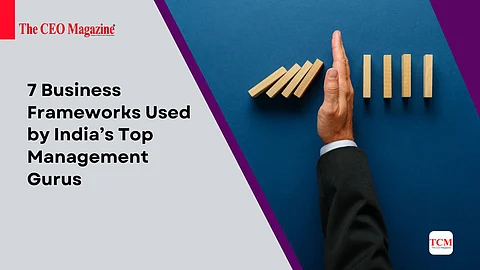
- News
- Women
- Magazine
- IndustryIndustry
- InsightsInsights
- Success Stories
- PublishPublish
- ContactContact
- Media KitMedia Kit

Business Frameworks
In uncertain markets, turbulent economies, and hyper-competitive landscapes, we all ask ourselves the same question:
"How do I make smarter, faster, and more strategic decisions?"
If you’ve ever wrestled with that question, you’re in good company.
The most successful leaders — from Ratan Tata to Narayana Murthy — don’t just trust instincts. They lean on proven frameworks used by India’s leading management thinkers to guide decision-making, align teams, and scale impact.
“Frameworks don’t restrict you — they liberate you. They give you structure to think clearly in chaos.” — My mentor once told me that, and it stuck.
In this article, I’ll walk you through 7 time-tested business frameworks that India’s top management gurus swear by.
These aren’t textbook theories — these are practical, battle-tested tools you can start using right now.
In fast-scaling startups or legacy organizations, the quality of your team defines the quality of your outcomes.
T.N. Hari — a respected HR strategist and advisor to Sequoia-backed ventures — emphasizes talent density as a growth lever.
Hire fewer, better people: Focus on A-players who can multiply output, not just add.
Create a performance culture: Prioritize radical transparency, real-time feedback, and accountability.
Let go early: Don’t delay tough decisions on underperformers.
Hari implemented this framework at BigBasket, helping it scale from a startup to a household name, while maintaining high execution standards.
“High talent density is the antidote to micro-management.”
Clarity isn’t optional — it’s foundational.
Dr. Ranjan Das, former professor of strategy at IIM Calcutta, taught thousands of leaders the Strategic Clarity Grid, designed to help organizations focus on the right things at the right time.
Clarity of Objectives: Are we solving the right problem?
Clarity of Priorities: Are we allocating resources effectively?
Clarity of Roles: Does everyone know their accountability?
Clarity of Outcomes: Do we have clear success metrics?
This framework is especially powerful for SMEs and growing startups that struggle with scattered focus.
Tip: Use this during quarterly planning to avoid shiny-object syndrome.
Innovation can’t be random. It needs discipline, structure, and repeatability.
Dr. R.A. Mashelkar — India’s top scientist and innovation evangelist — advocates for the Innovation Funnel, which moves ideas from concept to market with precision.
Idea Generation
Feasibility Screening
Prototype & MVP Development
Market Testing & Feedback
Full-Scale Execution
This framework is especially helpful for enterprises launching new products or startups iterating quickly.
“India must move from jugaad to systematic innovation,” Mashelkar often says — and this funnel is how.
What separates great business leaders from good ones?
Dr. Gita Piramal — business historian and author of Business Maharajas — outlines the Leadership Triangle as the foundation of sustainable leadership.
Vision: Ability to think long-term and inspire teams.
Execution: Turning strategy into action with precision.
Adaptability: Navigating change and uncertainty with agility.
Example:
Infosys’s Narayana Murthy epitomized this framework — setting a visionary path, creating execution rituals, and staying nimble even during global crises.
Use this model to assess your own leadership balance.
In a post-COVID world, purpose is no longer a buzzword — it’s a business imperative.
Kiran Mazumdar-Shaw, founder of Biocon, has often credited her success to blending scientific excellence with social impact.
Define your “Why” beyond profit.
Align teams and KPIs with that deeper mission.
Make customers your co-innovators, especially in health or ESG-driven sectors.
Measure success with impact, not just revenue.
In my experience, startups that embed purpose from day one enjoy stronger brand equity and investor confidence.
“My success has been built on the idea that innovation and purpose are not mutually exclusive.” — Mazumdar-Shaw
For hospitality and customer-centric industries, service is your brand.
P.R.S. Oberoi, who transformed The Oberoi Group into a global luxury brand, created a simple yet powerful service flywheel.
Train deeply → Empower frontline teams → Deliver ‘wow’ moments → Earn loyalty → Gain referrals → Repeat.
It’s a continuous loop — not a checklist.
Use this if your business relies on customer experience — be it B2B SaaS or retail.
Pro tip: Measure your NPS (Net Promoter Score) quarterly to track service effectiveness.
India’s Missile Man wasn’t just a scientist — he was a master strategist and leader of large-scale national projects. His framework is applicable to both startups and governments.
Vision: What future do we want to create?
Mission: What are our specific goals to get there?
Execution: What actions must we take consistently?
India’s Vision 2020 document, led by Kalam, used this exact model — combining high aspirations with grounded planning.
“Dreams transform into thoughts, and thoughts result in action.” — Dr. Kalam
If you're building something bold — like a climate-tech firm or a national-scale app — this framework keeps you anchored.
Here’s the secret:
Every successful leader I’ve interviewed — from CXOs of unicorns to founders in Tier-2 cities — uses mental models and frameworks to navigate complexity.
You don’t need to reinvent the wheel.
But you do need a map.
These seven business frameworks used by India’s top management gurus are your navigation tools — whether you’re scaling a startup, transforming a legacy company, or building from zero.
So the next time you face a strategic dilemma, ask yourself:
“Which framework helps me think clearly here?”
You’re not alone — the greats do it too.
Which of these frameworks will you apply first in your business?
Tag your co-founder, CXO, or leadership team and start a discussion.
Want deeper dives into each framework?
Let me know — we’re working on a full eBook for modern Indian business leaders.
Follow us on Google News
